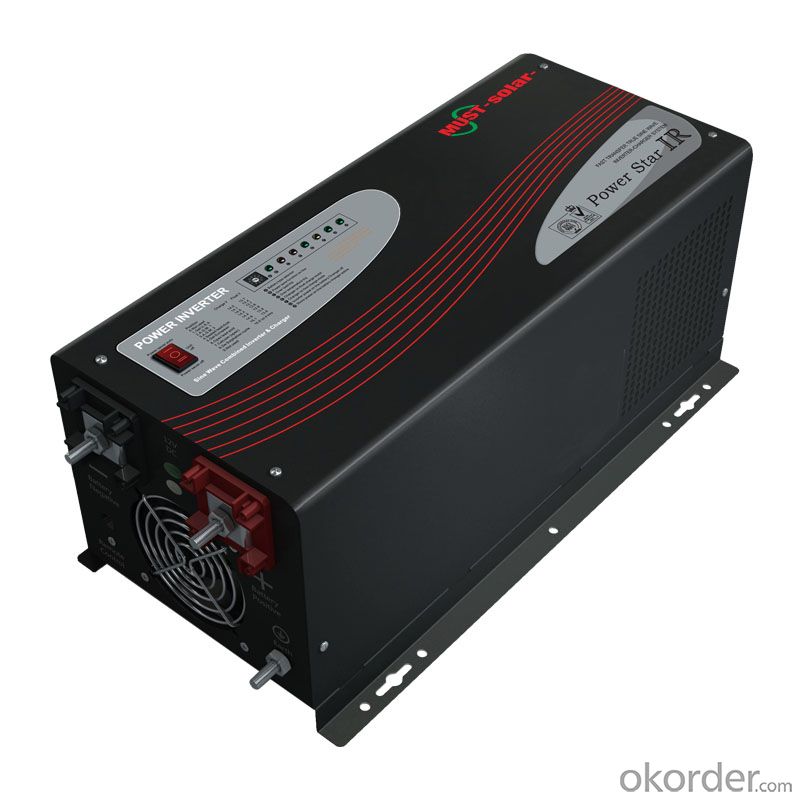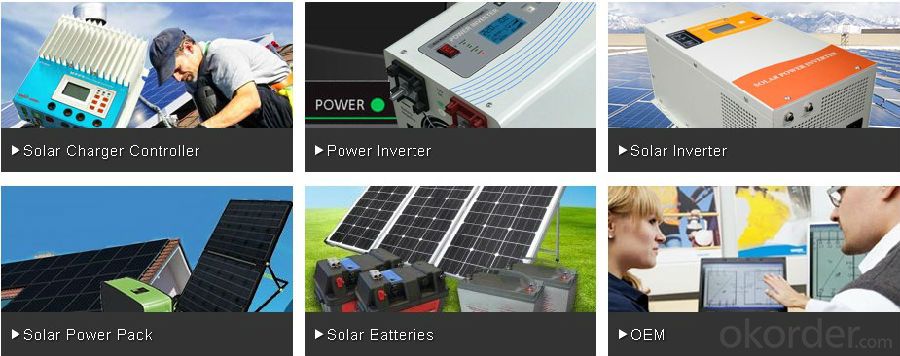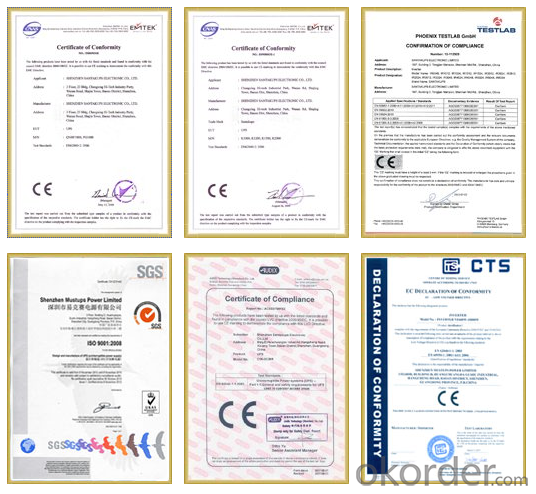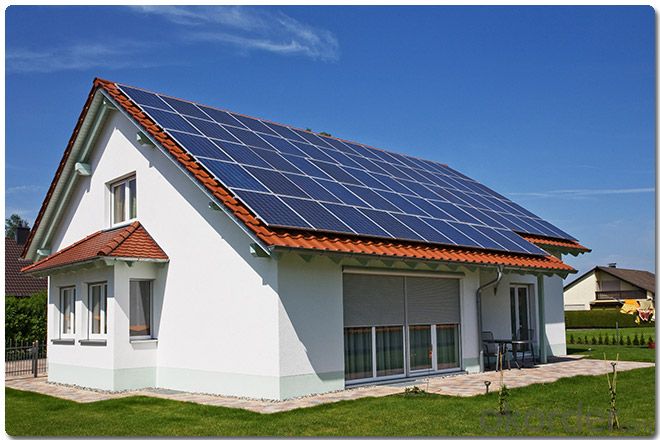2000W Pure Sine Wave InverterTop Selling South Africa CE Approved EP 3000 24V
- Loading Port:
- China main port
- Payment Terms:
- TT OR LC
- Min Order Qty:
- 100 pc
- Supply Capability:
- 1000 pc/month
OKorder Service Pledge
OKorder Financial Service
You Might Also Like
High efficiency over 90%
12Vac/24Vac/48Vac
Max.charge current 70A
Inbuilt pure copper transformer
Automatic three-stage battery Charger
RS232 with free CD(option)
Solar first function(option)
Charge current adjustable(option)
Remote control(option)
CE certificate, Soncap certificate.



| MODEL | EP3000 Series 1-3KW | ||||||
| EP3000 | 1012E | 1512E | 2012E | 2024E | 3012E | 3024E | 3048E |
| LINE MODE SPECIFICATIONS: | |||||||
| Input Voltage Waveform | Sine wave (utility or generator) | ||||||
| Nominal Input Voltage | 230Vac(120VAC selectable) | ||||||
| Low Line Disconnect | 155Vac±2% | ||||||
| Low Line Re-connect | 164Vac ±2% | ||||||
| High Line Disconnect | 272Vac±2% | ||||||
| High Line Re-connect | 265Vac±4% | ||||||
| Max AC Input Voltage | 270Vrms | ||||||
| Nominal Input Frequency | 50Hz/ 60Hz(Auto detection) | ||||||
| Low Line Frequency Re-connect | 58+0.3Hz for 60Hz;48+0.3Hz for 50Hz; | ||||||
| Low Line Frequency Disconnect | 57+0.3Hz for 60Hz;47+0.3Hz for 50Hz; | ||||||
| High Line Frequency Re-connect | 64+0.3Hz for 60Hz;54+0.3Hz for 50Hz; | ||||||
| High Line Frequency Disconnect | 65+0.3Hz for 60Hz;55+0.3Hz for 50Hz; | ||||||
| Output Voltage Waveform | As same as Input Waveform | ||||||
| Over-Load Protection(SMPSload) | Circuit breaker | ||||||
| Output Short Circuit Protection | Circuit breaker | ||||||
| Efficiency (Line Mode) | >95% | ||||||
| Transfer Switch Rating | 30A | ||||||
| Transfer Time (Ac to Dc) | 10ms (typical) | ||||||
| Transfer Time (Dc to Ac) | 10ms (typical) | ||||||
| Pass Through Without Battery | Yes | ||||||
| Max Bypass Overload Current | 30A | ||||||
| INVERT MODE SPECIFICATIONS: | |||||||
| Output Voltage Waveform | Sine wave | ||||||
| Rated Output Power (VA) | 1000 | 1500 | 2000 | 2000 | 3000 | 3000 | 3000 |
| Rated Output Power (W) | 1000 | 1500 | 2000 | 2000 | 3000 | 3000 | 3000 |
| Power Factor | 0~1.0 | ||||||
| Nominal Output Voltage (V) | 230Vac | ||||||
| Nominal Output Frequency (Hz) | 50Hz ± 0.3Hz | ||||||
| Auto Tracking Main Frequency(Hz) | Yes (Following Main first connection)50Hz @48-54Hz ;60Hz @58-64Hz | ||||||
| Output Voltage Regulation | ±10% rms | ||||||
| Nominal Efficiency | >80% | ||||||
| Over-Load Protection(SMPS load) | (110%150% ±10%:Fault (shutdown output) after 20s; | ||||||
| Surge Rating (10s) | 3000VA | 4500VA | 6000VA | 6000VA | 9000VA | 9000VA | 9000VA |
| Capable Of Starting Electric Motor | 1 HP | 1 HP | 1 HP | 1 HP | 2HP | 2 HP | 2 HP |
| Output Short Circuit Protection | Current limit (Fault after 10s) | ||||||
| Inverter Breaker Size | 10A | 10A | 30A | 30A | 30A | 30A | 30A |
| Nominal DC Input Voltage | 12V | 12V | 12V | 24V | 12V | 24V | 48V |
| Min DC Start Voltage | 10V/20V/40V | ||||||
| Low Battery Alarm | 10.5Vdc ± 0.3Vdc for 12V battery;21.0Vdc ± 0.6Vdc for 24V battery;42.0Vdc ± 0.6Vdc for 48V battery | ||||||
| Low DC Input Shut-Down | 10.0Vdc ± 0.3Vdc for 12V battery;20.0vdc± 0.6Vdc for 24V battery;40.0Vdc± 0.6Vdc for 48V battery | ||||||
| High DC Input Alarm & Fault | 16Vdc ± 0.3Vdc for 12V battery;32Vdc ± 0.6Vdc for 24V battery; 64Vdc ± 0.6Vdc for 48V battery | ||||||
| High DC Input Recovery | 15.5Vdc ± 0.3Vdc for 12V battery;31.0Vdc ± 0.6Vdc for 24V battery; 62.0Vdc ± 0.6Vdc for 48V battery | ||||||
| Power Saver | Load ≤25W (Enabled on "P/S auto" setting of Remote control) | ||||||
| CHARGE MODE SPECIFICATIONS: | |||||||
| Nominal Input Voltage | 230Vac | ||||||
| Input Voltage Range | 165V-265V | ||||||
| Nominal Output Voltage | According to the battery type | ||||||
| Nominal Charge Current | 35A | 45A | 65A | 35A | 75A | 45A | 30A |
| Charge Current Regulation | ± 5Adc | ||||||
| Battery Initial Voltage | 0 –15.7 Vdc/31.4Vdc/62.8Vdc (can operate with 0V battery) | ||||||
| Charger Short Circuit Protection | Circuit breaker | ||||||
| Over Charge Protection | Bat. V ≥ 15.7Vdc/31.4Vdc/62.8Vdc,beeps 0.5s every 1s & fault after 60s | ||||||
| GENERAL SPECIFICATIONS: | |||||||
| Safety Certification | CE | ||||||
| Operating Temperature Range | 0°C to 40°C | ||||||
| Storage Temperature | 15°C below zero to 60°C | ||||||
| Operation Humidity | 5% to 95% | ||||||
| Audible Noise | 60dB max | ||||||
| Cooling | Forced air, variable speed fan | ||||||
| Size | 1012E/1024E/2012E/2024E/2048E | ||||||
| 3012E/3024E/3048E: | |||||||
| G.W | 1kw-20KG 1.5kw,2kw-23KG 3kw-28KG | ||||||



Warrenty
provides a 1~3 year limited warranty (“Warranty”) against defects in materials and workmanship for its Uninterruptible power supply, Power inverter/chargers, Solar charge controllers, Battery Products (“Product”).
The term of this Warranty begins on the Product(s) initial purchase date, or the date of receipt of the Product(s) by the end user, whichever is later. This must be indicated on the invoice, bill of sale, and/or warranty registration card submitted to MUST-Solar. This Warranty applies to the original MUST-Solar Product purchaser, and is transferable only if the Product remains installed in the original use location.
FAQ
1. How do I decide which system is right for me ?
For protection from long outages, include a generator or solar panels in your Must solar system. Shorter outages can be handled by a battery-only system.
2. Where my system will be installed ?
Must solar systems are usually wall-mounted near a home's main electrical (circuit breaker) panel.
3. How do I install my system ?
A must solar backup inverter is connected to a home electric system , we will supply detailed installation manual and videos for our customers .
- Q:How does a solar inverter handle varying solar irradiance levels?
- A solar inverter handles varying solar irradiance levels by continuously monitoring the incoming solar energy and adjusting its output accordingly. When the solar irradiance level is high, the inverter increases its output voltage to maximize power conversion. Conversely, when the solar irradiance level drops, the inverter reduces its output voltage to maintain a steady and efficient power conversion. This adaptive response ensures that the solar inverter efficiently converts the available solar energy into usable electricity regardless of the varying solar irradiance levels.
- Q:Can a solar inverter be used with a solar tracker system?
- Yes, a solar inverter can be used with a solar tracker system. A solar inverter is responsible for converting the direct current (DC) produced by solar panels into alternating current (AC) that can be used to power electrical devices. A solar tracker system, on the other hand, is designed to maximize the efficiency of solar panels by orienting them towards the sun throughout the day. By using a solar inverter in conjunction with a solar tracker system, the generated electricity can be efficiently converted and used for various applications.
- Q:What are the different types of solar inverters available?
- There are several types of solar inverters available, including string inverters, microinverters, and power optimizers.
- Q:How does a solar inverter protect against power surges?
- A solar inverter protects against power surges by constantly monitoring the voltage and current levels of the solar panels and adjusting them accordingly. It has built-in surge protection devices that detect any sudden increase in voltage or current and divert the excess energy away from the solar panels, preventing damage to the system. Additionally, the inverter is equipped with advanced circuitry and protective components that can absorb and dissipate the excess energy, ensuring a stable and safe operation of the solar power system.
- Q:Can a solar inverter be used with different types of batteries?
- Yes, a solar inverter can be used with different types of batteries as long as the voltage and current ratings of the batteries are compatible with the inverter's specifications. However, it is important to ensure that the inverter is programmed or configured correctly to work with the specific battery chemistry and charging requirements to optimize performance and prevent any potential damage.
- Q:Can a solar inverter be used with bifacial solar panels?
- Yes, a solar inverter can be used with bifacial solar panels. Bifacial solar panels can generate electricity from both sides, capturing sunlight from both the front and back surfaces. The solar inverter is responsible for converting the DC power generated by the solar panels into AC power that can be used in homes or fed into the grid. Therefore, a solar inverter is an essential component for any solar panel system, including those with bifacial panels.
- Q:How does a solar inverter handle voltage regulation?
- A solar inverter handles voltage regulation by continuously monitoring the incoming voltage from the solar panels and adjusting its output voltage accordingly. It ensures that the voltage produced by the solar panels is converted to the appropriate level for efficient use in the electrical system. This helps to maintain a stable and consistent voltage output, protecting the connected devices and optimizing energy conversion.
- Q:Can a solar inverter be used for commercial-scale solar installations?
- Yes, a solar inverter can be used for commercial-scale solar installations. Solar inverters are essential components of any solar PV system, converting the DC electricity generated by solar panels into AC electricity suitable for commercial use. They are available in various sizes and capacities, allowing them to accommodate the power requirements of large-scale commercial installations. Additionally, advanced features like grid-tie functionality and monitoring capabilities make solar inverters suitable for integration into commercial-scale solar installations.
- Q:How does a solar inverter handle voltage dips or fluctuations in the grid?
- A solar inverter handles voltage dips or fluctuations in the grid by constantly monitoring the grid voltage. When it detects a dip or fluctuation, it adjusts its own output voltage accordingly to maintain a stable and consistent power supply. This helps protect connected devices from potential damage and ensures that the solar system continues to operate efficiently.
- Q:Can a solar inverter be used in a commercial solar system?
- Yes, a solar inverter can definitely be used in a commercial solar system. In fact, solar inverters are an essential component in converting the direct current (DC) electricity generated by solar panels into alternating current (AC) electricity that is compatible with the electrical grid and can be used by commercial buildings and businesses.
1. Manufacturer Overview |
|
|---|---|
| Location | |
| Year Established | |
| Annual Output Value | |
| Main Markets | |
| Company Certifications | |
2. Manufacturer Certificates |
|
|---|---|
| a) Certification Name | |
| Range | |
| Reference | |
| Validity Period | |
3. Manufacturer Capability |
|
|---|---|
| a)Trade Capacity | |
| Nearest Port | |
| Export Percentage | |
| No.of Employees in Trade Department | |
| Language Spoken: | |
| b)Factory Information | |
| Factory Size: | |
| No. of Production Lines | |
| Contract Manufacturing | |
| Product Price Range | |
Send your message to us
2000W Pure Sine Wave InverterTop Selling South Africa CE Approved EP 3000 24V
- Loading Port:
- China main port
- Payment Terms:
- TT OR LC
- Min Order Qty:
- 100 pc
- Supply Capability:
- 1000 pc/month
OKorder Service Pledge
OKorder Financial Service
Similar products
New products
Hot products
Hot Searches
Related keywords































